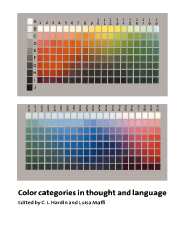Book contents
- Frontmatter
- Contents
- Notes on contributors
- 1 Introduction
- I THE WORLD COLOR SURVEY
- II VISUAL PSYCHOLOGISTS
- 3 The psychophysics of color
- 4 Physiological mechanisms of color vision
- 5 The neuropsychology of color
- 6 Insights gained from naming the OSA colors
- 7 Beyond the elements: investigations of hue
- 8 Color systems for cognitive research
- III ANTHROPOLOGISTS AND LINGUISTS
- IV DISSENTING VOICES
- 16 Closing thoughts
- Subject index
- Author index
4 - Physiological mechanisms of color vision
Published online by Cambridge University Press: 20 August 2009
- Frontmatter
- Contents
- Notes on contributors
- 1 Introduction
- I THE WORLD COLOR SURVEY
- II VISUAL PSYCHOLOGISTS
- 3 The psychophysics of color
- 4 Physiological mechanisms of color vision
- 5 The neuropsychology of color
- 6 Insights gained from naming the OSA colors
- 7 Beyond the elements: investigations of hue
- 8 Color systems for cognitive research
- III ANTHROPOLOGISTS AND LINGUISTS
- IV DISSENTING VOICES
- 16 Closing thoughts
- Subject index
- Author index
Summary
Color vision in general
Our world appears brightly colored, the colors – “natural” or artificial – drawn from huge palettes of pigments, dyes, and lights. But despite the ubiquity of color and the many studies of it, our knowledge of color is still filled with surprising gaps and misconceptions. Part of the problem is that there is no one “correct” way to ask about color: we each approach it with the preconceptions of our different disciplines. To bolster our “givens,” we show how they accord with “facts” from neighboring disciplines. For example, linguists have been known to justify some of their conclusions by showing that they agree with the known categories of neuronal responses delineated by physiologists (e.g. Berlin and Kay 1969; Kay, Berlin, and Merrifield 1991), and physiologists have returned the compliment by referring to the universal color categories discovered by the linguists (e.g. Ratliff 1976, 1992). Unfortunately each of the many approaches to color vision has its own set of unvoiced problems. My role is both to describe some of the physiological mechanisms that might underlie color vision and to uncover some of the skeletons hidden in my discipline's intellectual closets. (See Abramov and Gordon 1994 for a detailed treatment of many of these issues.)
Since color is a response of the nervous system to certain stimuli, the goal is to answer the question, “How does the human nervous system encode those aspects of the stimulus that elicit color sensations?” Obviously much of the work I describe is done on nonhuman species.
- Type
- Chapter
- Information
- Color Categories in Thought and Language , pp. 89 - 117Publisher: Cambridge University PressPrint publication year: 1997
- 14
- Cited by



